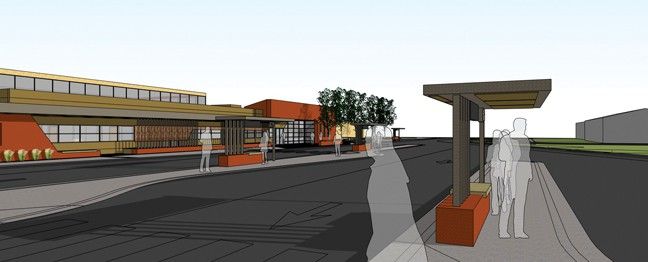Greeley bus system set for overhaul

GREELEY – An improved city transit system for Greeley? Probably coming soon.
More connections for Greeley commuters with the rest of the Front Range? Not yet on the drawing board.
The Weld County seat is the nation’s eighth-fastest-growing metropolitan statistical area, according to U.S. Census Bureau figures released in late March. The city of Greeley itself has witnessed its population surge toward 100,000, fueled in part by the oil and gas industry. Unlike the string of cities west of Interstate 25, however, Greeley’s transit connections to the rest of the Front Range remain severely limited.
SPONSORED CONTENT
Federal District Court Rules Corporate Transparency Act Unconstitutional . . . But Most Small Businesses Must Still Comply
Lyons Gaddis Real Estate and Business Attorney Cameron Grant shares important details of the Corporate Transparency Act (CTA).
Bustang, the Colorado Department of Transportation’s new I-25 regional service connecting Fort Collins and Loveland with Denver’s Union Station transit hub, still is scheduled to launch in late spring, and the Fort Collins and Loveland city bus systems – Transfort and COLT, respectively – are extending local routes to connect with it.
So far, Greeley officials say, that city’s transit system will not.
Ridership had been low on a U.S. 34 Express bus that operated hourly between Greeley Mall and the Centerra area from August 2008 to spring 2010, said Will Jones, Greeley city transit manager – but that was before Bustang and the rapid connection to Denver it promises.
“We’d have to do a mobility study to see what demand would be, and we first want to see what ridership on the Bustang turns out to be,” he said. “We want to make sure we have due diligence to evaluate what ridership would be before proposals are made to City Council and we throw service out there.”
At least some demand does exist, Jones said – especially when talks with JBS USA about better coordinating city bus schedules with the beef-processing plant’s shift changes revealed that 400 to 500 workers at the plant commute to Greeley from the Denver area.
“As much traffic as there is on 34 in the mornings, I certainly think it could be a benefit,” said Kim Barbour, public affairs director for the Greeley Chamber of Commerce.
So far, she said, not many modes of regional transit are available for Greeley residents who either don’t want to drive or can’t.
Arrow/Black Hills Stage Lines also serves Greeley with one daily bus each direction on its north-south route along U.S. Highway 85 between Denver and Cheyenne – but the schedule and fares haven’t exactly been conducive for commuters. An Arrow bus leaves Greeley at 5:40 a.m. and arrives in downtown Denver at 6:40 a.m., but the only return trip doesn’t leave Denver until half past midnight, reaching a slumbering Greeley at 1:35 a.m.
According to the Arrow website, the cost of a trip from Greeley to Denver and back is $46.50.
Round-trip fares between Fort Collins and Denver on Bustang will be less than half that, said CDOT spokesman Jared Fiel.
A prototype purple-and-black Bustang bus made an appearance at the St. Patrick’s Day Parade in Fort Collins “and we had people gobbling up the schedules,” Fiel said.
CDOT has been running the Bustang coaches to refine timing on the route, and working out issues with the park-and-rides at I-25 and U.S. 34 in Loveland and at I-25 and Harmony Road in Fort Collins, said Fiel. Completing that process has delayed what was to be an April start for the service until late spring or early summer, he said.
Within Greeley, riders are looking forward to a new central transfer center and streamlined local bus routes next year.
Greeley-Evans Transit, or GET, the city-owned bus system, won a $1.5 million grant from CDOT’s “FASTER” program – the Funding Advancements for Surface Transportation and Economic Recovery Act, passed by the Colorado Legislature in 2009 – to build a new transit center at 1200 A St. in the Island Grove Park area north of downtown. Its air-conditioned 2,500-square-foot interior will have about 35 seats and will replace an old downtown transfer center near Lincoln Park that will make way for a new convention center.
The reconfigured city bus routes will take effect in January. They would replace current routes that travel in loops with straightened courses, increase bus frequency and adjust timing to make transfers smoother.
“Now, our system tries to touch everybody’s doorstep,” he said. Using the image of a clock face, Jones described some routes where “riders board at ‘3 o’clock’ and have to ride all the way around to ‘noon.’ to get to their destinations.” Straightening the routes would not only increase ridership, he said, but also would lower the system’s cost per mile.
The final word on new routes will come from city officials in May, and Jones said he expects approval.
GREELEY – An improved city transit system for Greeley? Probably coming soon.
More connections for Greeley commuters with the rest of the Front Range? Not yet on the drawing board.
The Weld County seat is the nation’s eighth-fastest-growing metropolitan statistical area, according to U.S. Census Bureau figures released in late March. The city of Greeley itself has witnessed its population surge toward 100,000, fueled in part by the oil and gas industry. Unlike the string of cities west of Interstate 25, however, Greeley’s transit connections to the rest of the Front Range remain severely limited.
Bustang,…
THIS ARTICLE IS FOR SUBSCRIBERS ONLY
Continue reading for less than $3 per week!
Get a month of award-winning local business news, trends and insights
Access award-winning content today!


